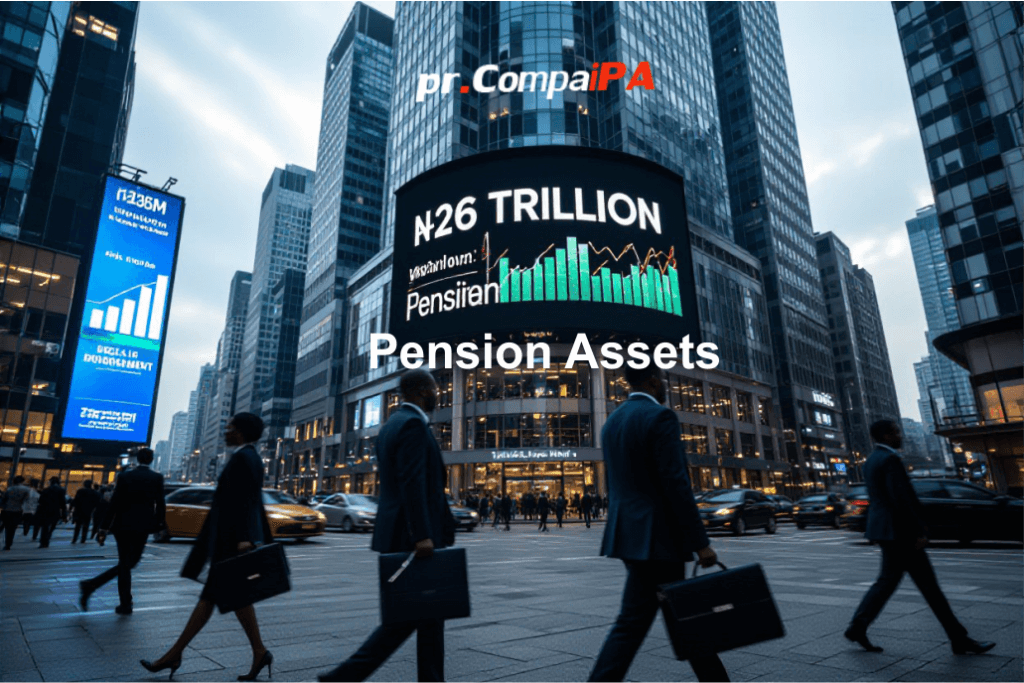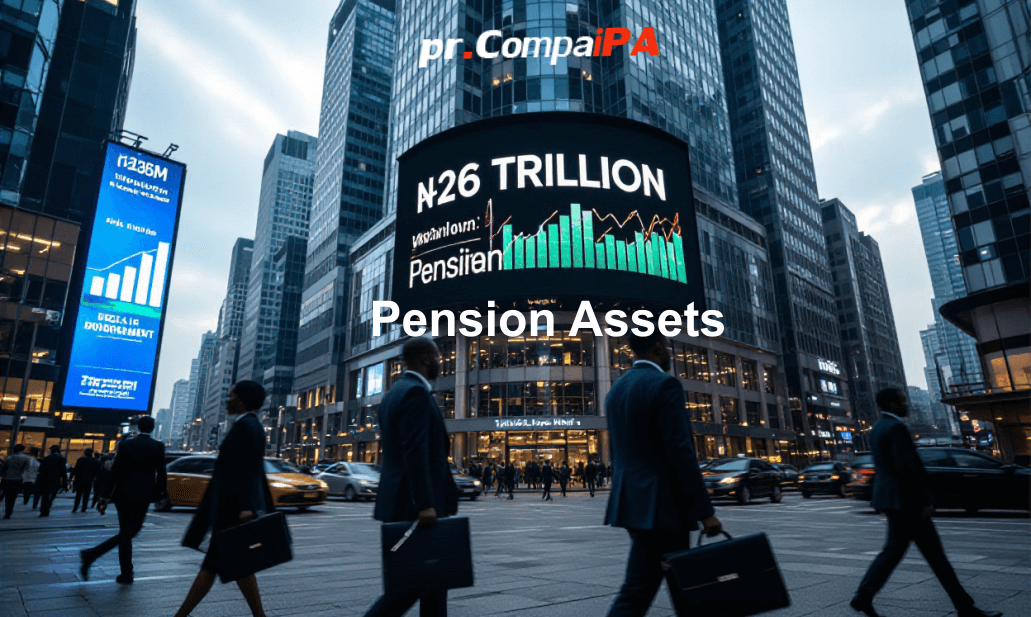Pension Assets Hit ₦26 Trillion with Strong 22% Growth, Says PenCom
Pension money sounds boring on the surface, but have you asked yourself what it really means for you when Nigeria’s pension fund jumps to ₦26 trillion with a strong 22% growth? You’re not just watching numbers on a spreadsheet – you’re watching your future income base shift as PFAs quietly pile more of your retirement savings into Federal Government securities, which PenCom says are now doing a lot of the heavy lifting for portfolio growth and stability.
Key Takeaways:
- Nobody expected pension money to grow this fast in a tough economy, but Nigeria’s pension assets quietly climbed to about ₦26 trillion, showing retirees’ savings are actually compounding pretty nicely in the background.
- A 22% jump in one year is no joke – that kind of growth means PFAs aren’t just parking funds, they’re actively chasing yield, especially in places that feel safer, like Federal Government securities.
- Federal Government bonds and related securities are clearly the main playground now, with PFAs leaning harder into them as rates stay relatively attractive and default risk on FGN paper is seen as low compared to private issuers.
- This stronger tilt towards government assets tells you PFAs are trading some upside for stability, which makes sense when you’re managing retirement funds and can’t afford wild volatility or big headline losses.
- PenCom’s tight oversight is a big part of this story – the growth is happening inside a fairly structured, rules-heavy system, which is boring on the surface but great if you just want your pension to show up when you’re older.
- For workers contributing every month, this kind of asset growth quietly boosts confidence in the funded system, because it signals their future payouts are backed by a growing pool, not a shrinking one.
- One big question going forward is how long PFAs can stay so heavily tilted to government securities before they start shifting more into corporate, infrastructure, or alternative assets to keep returns competitive.
What’s Pumping Up Nigeria’s Pension Fund?
Strong Growth Stats You Should Know
You care about that ₦26 trillion number because it quietly tells you if your future retirement lifestyle is getting safer or shakier. Over the last year, total pension assets jumped roughly 22%, which is wild in an economy still battling high inflation, FX pressure, and sluggish growth. PenCom data shows that Federal Government securities alone now soak up well over 60% of total pension assets, and that steady income from FGN bonds and treasuries is doing a lot of the heavy lifting for your long-term balance.
What really stands out is how consistent the flow of new funds has become. Monthly contributions from workers and employers are adding tens of billions of naira every month, and with more states joining the Contributory Pension Scheme, the pool keeps expanding. So you now have this interesting combo: fresh contributions flowing in + investment returns compounding on a bigger base, which is why your RSA statement is starting to show more than just slow, boring growth.
How PFA Investments Are Changing the Game
You might think PFAs are just parking your money in whatever is safest and calling it a day, but that playbook is shifting. While Federal Government securities are still the main anchor, PFAs are actively reshuffling between long-term FGN bonds, short-term treasury bills, and even Sukuk to ride interest rate cycles and squeeze out better returns for you. When rates were hiked, many PFAs tilted more into high-yielding FGN bonds, locking in double-digit coupons that directly boost your long-run portfolio value.
At the same time, portfolio allocations are slowly opening up beyond just government paper, so that you are not stuck in a one-trick pony portfolio. Some PFAs are increasing exposure to corporate bonds, infrastructure funds, and carefully selected equities, especially in sectors like banking, telecoms, and consumer goods that still throw off solid dividends. What this really means is that your pension fund is gradually moving from a passive, set-and-forget strategy into something closer to active risk management, where PFAs try to balance safety with better growth so your retirement pot can actually outrun inflation, not just trail behind it.
Because of that shift, you are seeing PFAs pay more attention to duration, credit quality, and diversification, not just ticking regulatory boxes. For example, many funds are shortening duration on some bonds to reduce price risk in case rates spike again, while using a slice of the portfolio for long-term infrastructure-related investments that can provide inflation-linked cash flows. And when they rotate into blue-chip stocks that benefit from naira devaluation or strong domestic demand, they are basically trying to add an extra engine of growth to your savings, so that in 10 to 20 years, your pension pot is not just big on paper, but big in real, spendable value.
Why Government Securities Are the Real MVPs
What Are Federal Government Securities Anyway?
In 2024, the Federal Government of Nigeria (FGN) securities soaked up well over 60% of total pension assets, which tells you immediately they’re not some niche side play. You’re basically looking at a menu of instruments like FGN Bonds (2 to 30 years), Treasury Bills (as short as 91 days), Sukuk (asset-backed and infrastructure-focused), and Savings Bonds that even retail investors can access from as low as ₦5,000. Each one has a different tenure, different cash flow pattern, but they all sit on the same foundation – the full faith and credit of the Federal Government.
In practical terms, when your PFA buys FGN Bonds for your Retirement Savings Account, you’re effectively lending money to the government to build roads, service debt, or plug budget gaps, and in exchange, you get predictable interest payments, known as coupons. T-bills are more your short-term parking lot for cash, providing liquidity and helping PFAs rebalance portfolios without taking wild swings, while FGN Sukuk has quietly become the go-to for infrastructure exposure that still sits inside a relatively low-risk bucket. So on the surface, they look boring, but that “boring” is exactly what stabilised that ₦26 trillion in pension money while other risky assets were having mood swings.
The Trust Factor: Why Investors Are All In
Over 70% of RSA funds in Nigeria are consistently allocated to FGN securities, not because PFAs lack imagination, but because you need something rock solid at the heart of a retirement system. You know how Nigerian equities can be – one year double-digit returns, the next year a brutal correction – government paper gives your portfolio that steady heartbeat that doesn’t spike every time there’s a political headline. When your PFA loads up on FGN Bonds, they’re basically saying: “your retirement shouldn’t depend on vibes and speculation.”
Another thing you can’t ignore is regulation, and how it actually reinforces that trust. PenCom guidelines actively push PFAs to prioritise investment-grade, high-quality fixed income, and FGN securities sit pretty at the top of that list. Because there’s deep market liquidity in these instruments, PFAs can buy or sell in large volumes without blowing up prices, which means if you retire next month or next year, they can actually raise cash for your lump sum and programmed withdrawals without fire-selling risky assets at a loss. That reliability is why PFAs keep going back to the FGN paper, even when other shiny options pop up.
What really seals it for you as a contributor is the combo of predictability, transparency, and a long track record of the government meeting its obligations on local debt. You might not track yields every week, but PFAs do, and they’re watching auction results, interest rate trends, and inflation numbers to lock in opportunities where FGN Bonds deliver solid real returns after inflation. So while everyone else is chasing the next hot stock tip, your pension quietly compounds in instruments where default risk is extremely low, cash flows are scheduled to the last date, and the probability of you actually getting paid is about as high as it gets in the Nigerian market.

The Bigger Picture – What This Means for Nigerians
How Does This Affect Your Savings?
If you’re setting money aside every month, you want to know it’s not just sitting there doing nothing, right? With pension assets climbing to ₦26 trillion, what it really signals is that your retirement savings are part of a much bigger, more active pool of money that PFAs are putting to work, especially in Federal Government securities that now take up more than 60% of total pension assets. That heavy tilt into FGN Bonds and Treasury Bills basically means your funds are riding on the credit strength of the Nigerian government instead of random speculative bets.
On the upside, that gives you more stability and relatively predictable returns, especially compared to just dumping money in a low-interest savings account that might barely beat inflation. But you also need to be aware that when rates drop or inflation spikes beyond current yields, your real returns can get squeezed, so even though your RSA balance is going up in naira terms, your actual purchasing power in 15-20 years may not grow as fast as you expect. It’s why you should log into your RSA portal a few times a year, check the audited returns of your PFA’s fund category, and decide if you should move from Fund II to Fund III or Fund IV as you age, instead of just leaving your savings on autopilot.
The Future of Nigeria’s Retirement Landscape
When pension assets sit at ₦26 trillion and keep growing at 20%+ annually, the game starts to change for the whole retirement system, not just for individual workers. You’re going to see PFAs push harder into infrastructure funds, corporate bonds, and carefully screened equities as regulations allow, because relying almost entirely on FGN securities won’t cut it forever if Nigeria wants both higher long-term returns and real economic growth. That shift, if managed properly, can translate into better diversified portfolios for you, with multiple income streams backing your future pension payments instead of just government borrowing.
At the same time, that sheer asset size gives PenCom more leverage to enforce compliance, improve governance, and kick out weak or poorly managed PFAs that don’t meet performance or risk standards. So over the next decade, you might see fewer PFAs, but stronger ones, with sharper digital tools, clearer fees, and more competitive long-term returns – meaning your retirement planning could start to feel more deliberate and less like hoping things will sort themselves out when you’re 60.
As this plays out, you’ll probably notice more voluntary contributions, better micro-pension options for informal workers, and deeper financial products wrapped around pensions, like using your RSA balance for part-financing a home or structured annuities that pay you for life instead of a lump sum. If PFAs and PenCom keep using this growing asset base as long-term capital for real projects – power, housing, transport, agriculture – you won’t just benefit through a higher RSA balance, you’ll feel it in better infrastructure, more stable jobs, and a retirement life that isn’t built on constant financial stress.
My Take on the Pension Fund Boom
What this kind of growth really tells you
You’d expect ₦26 trillion sitting in pension assets to instantly translate into a better retirement outlook for you, but that’s only half true. What it really tells you is that PFAs are getting very comfortable loading up on Federal Government securities, because that’s where they see safety, liquidity, and fairly predictable returns in a messy macro environment. When you see over 60% of assets consistently parked in FGN bonds and treasury instruments, you’re basically seeing a system where your future is tightly tied to the government’s ability to manage debt and inflation without slipping.
At the same time, this growth signals that you’re already in one of the few financial systems in Nigeria that’s reasonably structured, regulated, and actually working at scale – which is rare. The fact that contributions kept rising through FX volatility, subsidy removal shock, and 20%+ inflation tells you retirement savings are quietly becoming the backbone of long-term capital in this country. That should matter to you, because it means your pension isn’t just some deduction on your payslip, it’s gradually turning into one of the few pools of money with the size and stability to actually shape the future of the Nigerian economy.
Where you should be both excited and a bit worried
What really jumps out for you is the tradeoff: your funds are growing in nominal terms, but inflation is aggressively biting into real returns, so a 15% average return against 20% inflation is effectively a negative result in real life. So while PenCom’s report looks impressive on paper, you can’t just see ₦10 million in your RSA statement and feel safe without asking what that will actually buy in 15 to 20 years if food, rent, and healthcare keep climbing the way they have since 2020. If your PFA is over-concentrated in one asset class, especially long-dated FGN bonds, you’re basically betting your future on macro stability that Nigeria doesn’t exactly have a flawless track record on.
Where you can be optimistic is the quiet shift into infrastructure funds, corporate bonds, and even carefully selected equities, because that’s where your pension can both beat inflation and support real economic activity at the same time. You want to see your RSA less passive and more intelligently diversified – not reckless, just smarter – with PFAs using their size to negotiate better terms, push for governance improvements, and avoid lazy herd behavior. If you’re not periodically checking your fund category (especially the Fund II vs Fund III vs micro pension options) and engagement from your PFA, you’re effectively leaving your future on autopilot in a country where autopilot has never been a safe strategy.
Is It Too Good to Be True?
When you see pension assets jumping to over ₦26 trillion and PFAs bragging about double-digit returns, you probably ask yourself: “Wait, is this thing actually sustainable or are we in a sweet spot that could flip on me later?” The numbers look fantastic on the surface, especially with a lot of the growth tied to higher yields on Federal Government securities. Still, whenever one asset class is doing the heavy lifting, pause for a second. Gains fueled by rising interest rates on FGN bonds feel great today, yet they’re also telling you something about inflation, government borrowing, and long-term risk that isn’t as sexy in the headlines.
Instead of getting carried away with the size of the fund, you want to ask a more uncomfortable question: “What has to keep going right for this story to continue?” You have regulatory stability, PFAs loading up on government debt, relatively limited equity exposure, and a macro environment where inflation is punching above 27% while nominal returns look strong on paper. That mix can work for a while, but if your real return (after inflation) isn’t growing as fast as the press release, then the shiny 22% growth starts to look a lot less magical.
Potential Risks Worth Considering
Have you noticed how much your pension statement leans on government paper these days? When over 60% of total pension assets sit inside FGN bonds, treasury bills, and related instruments, your retirement money is effectively betting that the government will keep borrowing, keep paying, and keep inflation somewhat in check. If fiscal stress worsens, if debt servicing keeps eating a bigger chunk of revenue, or if political pressure forces sudden changes in yields or debt restructuring, your “safe” assets may not feel so safe anymore.
Another thing you might be underestimating is concentration risk at the PFA level. Some PFAs are overweight in similar maturities, similar issuers, even similar strategies, so if one segment gets hit, a lot of funds move in the same painful direction. And while the current regulation by PenCom sets limits on equities, alternatives, and offshore exposure to protect you, it can also box your portfolio into a structure where you’re heavily exposed to interest rate and inflation shocks. That means your nominal balance can keep rising while your actual purchasing power in retirement quietly gets punched in the gut.
What Happens If the Market Shifts?
What do you think happens if interest rates suddenly drop or government borrowing slows down and PFAs can’t just rely on those juicy FGN yields anymore? In that kind of pivot, the bond prices you see on paper might rise, sure, but the future reinvestment rate on your money falls, which means new contributions and matured securities get parked at lower returns. Over a 10 to 20-year horizon, that shift can drag your overall portfolio performance way below what you’re getting excited about right now.
On the flip side, if rates spike even higher from already elevated levels, the mark-to-market value of longer-dated bonds in your pension portfolio can take a hit, making your statement look weaker in the short term, even if long-term yield potential improves. PFAs then face a tough balancing act between holding their positions, rotating into shorter maturities, or diversifying more into equities and alternatives at a time when market volatility might already be stressing everyone out. So you end up in this weird spot where the same forces that pumped your returns can flip and start working against you, often when you’re not even paying attention.
To make this even more real for you, think back to periods when FGN bond yields swung sharply, like when 10-year paper moved several hundred basis points within a year – PFAs that were sitting heavy in long-term bonds saw noticeable valuation swings even if they didn’t change strategy, and for a lot of RSA holders that showed up as slower growth or short-term dips in their quarterly statements. If, over the next few years, Nigeria’s inflation cools, Eurobond access improves, or debt management strategy shifts toward longer cheaper funding, the yield curve could flatten, forcing PFAs to look harder at equities, infrastructure funds and maybe even foreign assets to keep your returns competitive, and in that transition period your portfolio might experience more volatility than you’re used to, with performance differences between aggressive and conservative funds widening a lot more than what you see today.

The Real Deal About PenCom’s Role
How PenCom Is Guiding the Growth
People often think PenCom just sits in Abuja and writes long, boring regulations, but in reality, it’s more like a tough referee making sure PFAs don’t play games with your retirement money. By setting tight investment limits, PenCom has nudged PFAs to put a big chunk of assets into Federal Government securities, which now soak up well over 60% of total pension assets, anchoring that ₦26 trillion on relatively stable ground. Because of these rules, PFAs can’t just wake up and throw their funds into some flashy high-risk scheme; they have to follow specific asset allocation bands across FGN bonds, treasury bills, corporate debt, money market, equities, and alternatives.
On top of that, PenCom is constantly tweaking its guidelines to balance safety with returns, which is part of why you saw that 22% year-on-year growth in assets without a blow-up. It runs ongoing compliance checks, issues circulars when PFAs start getting too aggressive or too lazy, and even approves templates for things like valuation models so everyone plays by the same rulebook. That boring-sounding supervision is exactly what lets you sleep at night while your Retirement Savings Account is quietly compounding in the background.
Key Policies You Should Know About
A lot of people assume pension policy is just “they deduct your salary and that’s it”, but the real power sits in the fine print that shapes how your contributions are invested and protected. The Multi-Fund Structure Minimum Capital Requirements for PFAs were raised to force operators to beef up their capital base so they can absorb shocks instead of collapsing at the first sign of market stress.
Another policy many people sleep on is the Investment Regulation 2019 (and subsequent circulars), which pins down things like the minimum rating for corporate bonds, exposure caps to any single issuer, and how much PFAs can put into alternative assets like infrastructure funds or private equity. That’s why you’re seeing a slow, controlled move into infrastructure-backed instruments – Lagos-Ibadan expressway, some power projects, a few state bonds – instead of a wild rush that could blow up your portfolio if projects fail. Because PenCom also enforces strict custody and separation of functions (PFA manages, PFC holds the assets, PenCom oversees), your RSA isn’t just sitting inside the PFA’s own account; it’s ring-fenced, audited, and tracked line by line.
On a more practical level, you’ve also got policies around RSA transfers, which let you move from one PFA to another once a year if you’re unhappy with service or returns, and this has quietly pushed PFAs to up their game, improve reporting, and sharpen investment strategies. PenCom’s guidelines on micro-pensions opened the door for self-employed folks and informal workers to join the net, while the Programmed Withdrawal vs Annuity rules define how you actually access that money when you retire, what lump sum you can take, and how the “monthly salary” in retirement is calculated, so you’re not just at the mercy of your HR department’s interpretation.
To wrap up
With these considerations, ₦26 trillion in pension assets and a 22% growth rate in one year should make your ears perk up, because that’s not small money by any standard. What it says to you is that your retirement savings are sitting inside a system that’s getting deeper, more sophisticated, and more anchored in Federal Government securities that PFAs clearly trust. You don’t have to be a finance geek to see the signal here – stability, liquidity, and a long-term view are quietly working in your favor, even if it doesn’t feel exciting day to day.
With these considerations shaping the landscape, your real job now is to stay plugged in to how your own PFA is investing within this bigger ₦26 trillion story, not just assume “they’ll sort it out”. When you see strong growth and a big tilt toward government instruments, you should be asking yourself: Does this match my risk appetite, my retirement timeline, and the kind of future you actually want? Because at the end of the day, the numbers are national, but the impact is very personal – it’s your money, your future, your call.
FAQ
Q: What exactly does it mean that Nigeria’s pension fund is now at about ₦26 trillion with 22% growth?
A: Over the last year, pension assets managed by Pension Fund Administrators (PFAs) in Nigeria have climbed to roughly ₦26 trillion, and that jump represents around 22% year-on-year growth. In simple terms, the savings of workers under the Contributory Pension Scheme (CPS) are getting bigger, not just from monthly contributions, but also from investment returns.
That 22% growth rate signals that PFAs did a better job allocating funds, especially into Federal Government securities, which are seen as relatively safe and stable income generators. It also reflects higher yields on government bonds and Treasury bills, so your retirement money is not just sitting idle; it’s working in the background.
Q: How are PFAs using Federal Government securities to drive this kind of growth?
A: PFAs are channeling a significant portion of pension assets into instruments like Federal Government bonds, Treasury bills, Sukuk, and FGN savings bonds. These are backed by the Nigerian government, so they’re considered lower-risk compared to many private-sector instruments.
Because interest rates on these securities have been quite attractive recently, PFAs have been able to lock in better yields for contributors. So when you see a 22% growth figure, a big slice of that is coming from gains on these government-backed investments, not just more people contributing.
Q: What role does PenCom play in all this growth and investment activity?
A: PenCom (the National Pension Commission) is the regulator that sets the rules for how PFAs operate, invest, and report. It doesn’t manage your money directly, but it tells PFAs what they can invest in, the limits per asset class, and how they must protect contributors’ interests.
With the recent growth, PenCom has been tightening reporting standards, monitoring investment decisions more closely, and adjusting guidelines to reflect market realities. That mix of supervision and clear rules helps keep PFAs focused on safety first while still chasing acceptable returns, which is exactly what you want with retirement funds.
Q: As a contributor, how does this 22% growth affect my Retirement Savings Account (RSA)?
A: If you’ve got an RSA under the CPS, the growth of the overall pension industry usually translates into better returns on your individual account over time. It shows that, on average, PFAs are generating investment income, which gets reflected in the unit prices of the fund you’re enrolled in (like Fund II, Fund III, etc.).
Of course, the exact impact on your RSA depends on your specific PFA, the fund category you’re in, and how long you’ve been contributing. But in broad terms, a strong industry-wide jump to ₦26 trillion with 22% growth is a positive sign that your retirement pot is potentially getting fatter, not thinner.
Q: Is it actually safe that so much of the pension fund is invested in Federal Government securities?
A: Safety-wise, Federal Government securities are usually viewed as some of the most secure instruments in the local market because they’re backed by the sovereign. That’s exactly why PFAs lean heavily into them: they prioritize capital preservation and steady income over wild, speculative bets.
The flip side is concentration risk – when too much money sits in one broad asset class, it limits diversification. PenCom tries to manage this by setting asset allocation limits and encouraging PFAs to also invest in corporate bonds, money market instruments, and, in some cases, infrastructure or equities, but the government securities still take a very big slice of the pie.
Q: What does this growth mean for Nigeria’s economy as a whole?
A: A ₦26 trillion pension fund is not just a big number on paper; it’s long-term capital that the government and private sector can tap into for borrowing and investment. When PFAs buy Federal Government securities, they’re basically funding government projects, debt refinancing, and budget support.
Over time, a larger and more stable pension industry can deepen the local capital market, improve liquidity, and encourage more structured long-term financing. If the funds are increasingly directed into productive investments, it can support infrastructure, jobs, and growth – not just retirement payouts.
Q: What should workers and employers be paying attention to going forward?
A: Workers should keep an eye on their RSA statements, check the historical returns of their PFA, and understand which fund type they’re in, because growth at the industry level doesn’t cancel the need to track their personal numbers. It’s also smart to confirm that your employer is remitting contributions regularly and that they show up correctly in your account.
Employers, on the other hand, need to stay compliant with contribution timelines and keep good records to avoid penalties and disputes. With the fund size and growth getting bigger, both sides have more to gain – and more to lose – from sloppiness, so paying closer attention now will save a lot of stress later.
You can also read our related post for additional context and economic updates.
Kick-start your tailored Financial PR campaign today—elevate your visibility, strengthen credibility, and shape the narrative before others do. Fill out your choice campaign that fits your financial PR strategic direction –
Brand Brief PR Campaign Plan Form
Financial PR Narrative, Amplified Form, and
The Corporate Intelligence Exchange Newsroom Form
Act Now!

Expertly crafted to deliver clear, competitive economic insights for a wider audience, this article is authored by Adebola Adeola, CEO of Dinet Comms and PR CompaiPA.




